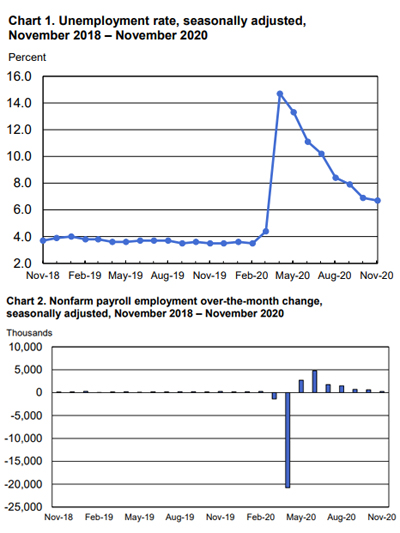
The U.S. economy added 245,000 non-farm jobs in November, below the 410,000-job growth forecast by economists. The unemployment rate edged down to 6.7 percent. While November is the seventh consecutive month of both job growth and unemployment rate improvement, the pace of that improvement has moderated reflecting the ongoing coronavirus and efforts to contain it.
However, as noted by Wall Street Journal reporter Sarah Chaney Jones, current vaccine rollout plans will be a factor in future job growth, “The labor-market recovery from the pandemic’s job destruction this spring has been stronger than most economists forecast. Many expect widespread vaccine distribution to eventually help lift the economy as businesses are allowed to reopen and consumers feel more comfortable traveling, going to the movies and returning to other in-person activities involving proximity to other people.”
The Bureau of Labor Statistics (BLS) reported in November, notable job gains occurred in transportation and warehousing, professional and business services, and healthcare. Employment declined in government and retail trade.
“With this month’s BLS Employment Situation report, the economy is once again reflecting a broad-based underlying optimism bolstered by recent COVID-19 vaccine announcements,” said Bert Miller, president and CEO of MRI. “Members of our Network of over 300 executive recruitment offices sense a building momentum particularly in sectors like healthcare, construction, financial services, and professional services as client firms intensify their search efforts for the top executive, technical, professional, and managerial talent who will lead the evolution of their business models into 2021.”
The BLS reported in November, 21.8 percent of employed persons teleworked because of the coronavirus pandemic, up from 21.2 percent in October. These data refer to employed persons who teleworked or worked at home for pay at some point in the last four weeks specifically because of the pandemic.
Commenting on the November report, Sameer Samana, senior global market strategist at The Wells Fargo Investment Institute noted, “While disappointing, this news should be somewhat offset by the increasing odds of another fiscal stimulus package, and a Fed that stands ready and willing to do more to help the economy.”
Looking to future months, David Berson, chief economist at Nationwide Mutual Insurance Co. provided an additional optimistic outlook, “As infection rates go down, as the number of people vaccinated goes up, then we’ll start to see … business activity expand at a faster rate, and we will see the employment numbers pick up more strongly.”
As reported by the BLS, employment in transportation and warehousing rose by 145,000 in November. Employment rose by 82,000 in couriers and messengers and by 37,000 in warehousing and storage; since February, employment in these industries has increased by 182,000 and 97,000, respectively. Job growth also occurred over the month in truck transportation (+13,000).
In November, employment in professional and business services increased by 60,000, with about half the gain occurring in temporary help services (+32,000). Job growth also occurred in services to buildings and dwellings (+14,000).
Healthcare added 46,000 jobs in November, with gains occurring in offices of physicians (+21,000), home healthcare services (+13,000), and offices of other health practitioners (+8,000). Nursing care facilities continued to lose jobs (-12,000). Overall, there are 527,000 fewer healthcare jobs than February.
Construction gained 27,000 jobs in November. Employment rose in residential specialty trade contractors (+14,000) and in heavy and civil engineering construction (+10,000).
In November, manufacturing employment increased by 27,000. Job gains occurred in motor vehicles and parts (+15,000) and in plastics and rubber products (+5,000).
Financial activities added 15,000 jobs in November. Gains occurred in real estate (+10,000) and in nondepository credit intermediation (+8,000). Financial activities have added 164,000 jobs over the past 7 months, but employment in the industry is 115,000 lower than in February.
Employment in wholesale trade continued to trend up in November (+10,000). Government employment declined for the third consecutive month, decreasing by 99,000 in November.
Employment in leisure and hospitality changed little in November (+31,000) but is down by 3.4 million since February. Arts, entertainment, and recreation added 43,000 jobs in November, while employment in food services and drinking places changed little (-17,000). Employment in other major industries, including mining, information, and other services, also showed little change in November.
“Our Network members are continuing to see client organizations invest boldly in growth, as they work to avoid the dangers of recency bias. We are helping our clients ensure they don’t over-index on the most recent global events to guide their decisions, but instead remain committed to objectively evaluating the full picture and focusing on what has historically driven economic vitality: great talent,” said Miller.
Read the full report here: https://www.bls.gov/news.release/pdf/empsit.pdf